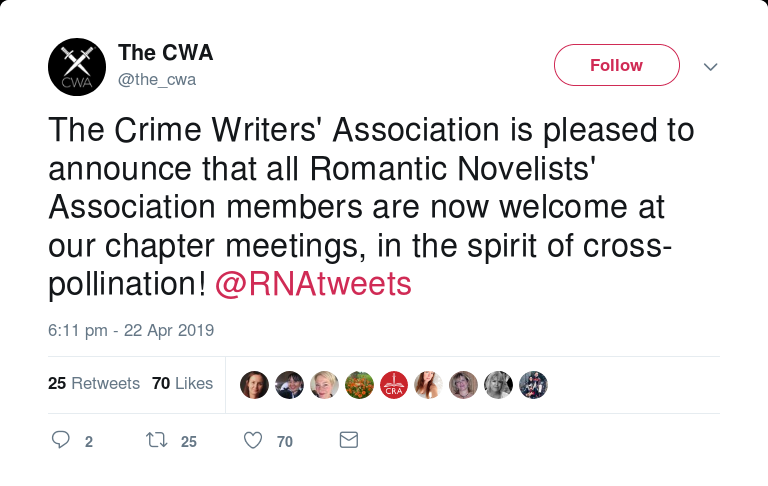I recently came across a foreword to a critical work about crime fiction which digressed into some pure speculation about romance readers. This foreword, by Professor Frances Washburn, asked
What is specific [...] about crime fiction that appeals to readers? Berthold Brecht, German dramatist and poet, wrote, "The crime novel is about logical thought and demands such logical thought from the reader. It is close to the crossword puzzle in that respect." And further, why is it that romance fiction still surpasses crime fiction in popularity, if only marginally?
I would contend that these two genres appeal to readers with differing psychological profiles, and while I have no evidence to support this assertion, it seems to me that romance readers seek fiction that is comforting, that allows them to believe familiar and timeless philosophies: that true love exists, that finding the perfect mate is possible, and that there is a happily ever after ending, if only between the covers of romance novels. Likely, these readers also believe, or want to believe, that everyone has a personal protective angel and that fairies could be real. Crime novel readers may be drawn to puzzle solving, which every murder mystery certainly is, unafraid to view the ultimate crime in gory detail, even if only between the pages of crime novels. Neither reader is superior or inferior, merely reading with different needs and different perspectives. (x, emphasis added)
There's so much to quibble with, question and dispute here: it ignores the fact that there are many readers who move between the two genres, that "cosy" mysteries may be comforting and may be chosen because they don't depict gore and that the philosophies listed are not "timeless". If romance readers believe in fairies, what about readers of fantasy? Does the juxtaposition of fairies and angels have implications for certain religious beliefs?

[Tweet from the Crime Writers' Association saying they're "pleased to announce that all Romantic Novelists' Association members are now welcome at our chapter meetings, in the spirit of cross-pollination!" (22 April 2019)]
I wouldn't deny, though, that there are certain core beliefs present in these two genres, that they appear to differ from each other, and that they probably evoke (or aim to evoke) different responses in their readers. Jennifer Crusie has argued that
the romance novel is based on the idea of an innate emotional justice in the universe, that the way the world works is that good people are rewarded and bad people are punished. The mystery genre is based on the same assumption, only there it’s a moral justice, a sense of fair play in human legal interaction: because the good guys risk and struggle, the murderers get punished and good triumphs in a safe world.
David Carter and Millicent Weber also touch briefly on romance and compare it to crime fiction, but in their case the analysis is very firmly founded on facts:
For genre fiction, romance - by far the largest of the generic categories, with 1766 titles published in 2013-2017 - is dominated unsurprisingly by HarperCollins's Harlequin and related imprints, responsible on their own for forty-eight per cent of romance titles in the period surveyed (for further analysis of genre publishing see Driscoll et al. 2018). In terms of market share, this figure is in fact a decline from the sixty-four per cent recorded for the period 2010-2013, indicating the recent commitment of other major players to the expanding romance market, not least through digital imprints such as PRH's Destiny Romance. HarperCollins, PRH [Penguin Random House], Pan Macmillan and Hachette between them cover sixty-one percent of new romance titles, and the vast majority of the remainder are self-published. By contrast, a much larger number of independents figure in crime publishing, which overall recorded 574 titles for the period. The prominence of these independents testifies to crime's higher cultural standing among genre forms and its generic investment in local settings. The multinationals, including Simon & Schuster, produced only seventeen per cent of crime titles in the period surveyed, while a group of local independents produced 22 per cent.
In sum, local independents are comparatively far more visible in literary and crime fiction publishing than in romance, thriller/adventure and fantasy. Medium-sized firms are substantially represented, but the multinationals dominate in both literary and genre fiction, that is, in both the more profitable and the more prestigious forms of publishing. (351)
---
Carter, David and Millicent Weber. "Fiction Publishing in Australia, 2013-2017". Publishing and Culture, ed. Dallas John Baker, Donna Lee Brien and Jen Webb. Newcastle upon Tyne: Cambridge Scholars, 2019. 341-58.
Crusie, Jennifer. "I Know What It Is When I Read It: Defining the Romance Genre".
Driscoll, Beth, Lisa Fletcher, Kim Wilkins and David Carter, 2018. "The Publishing Ecosystems of Contemporary Australian Genre Fiction". Creative Industries Journal 11.2: 203-21.
Washburn, Frances. "Foreword". Native American Mystery Writing: Indigenous Investigations, Mary Stoecklein. Lanham, Maryland: Lexington, 2019. ix-xi.
With thanks to Vassilikí Véros for drawing my attention to the timely Crime Writers' Association tweet.

Add new comment